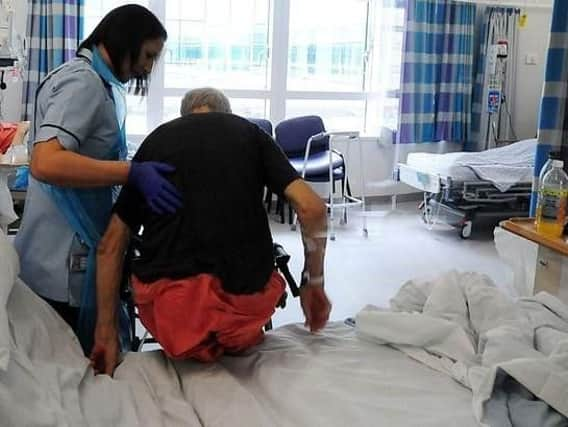'Bed blocking' is on the rise at Wigan's hospitals


A report published by the Care Quality Commission found “too much ineffective co-ordination” of health and social care services in England.
With elderly patients often stuck waiting to be signed off, there is concern over the impact delays can have on their health. According to the NHS, a hospital stay of more than 10 days for a person over 80 can lead to 10 years of muscle ageing.
Advertisement
Hide AdAdvertisement
Hide AdNHS England figures show that in August, patients at the Wrightington, Wigan And Leigh NHS Foundation Trust (WWL) spent a total of 214 days waiting to be discharged or transferred to a different care facility: the equivalent of seven months’ waiting time.
A delayed transfer of care occurs when a patient remains in a bed after being officially declared safe for transfer by both a doctor and a multidisciplinary team, which could include social or mental health care workers. Delays in transferring a patient between wards, or from one acute hospital to another, are not included.
Kate Terroni, chief inspector of adult social care for the CQC, said: “When people can’t access the services they need, the risk is that they are pushed into inappropriate care settings and stay there for too long rather than accessing the care they need within their community.”
At WWL, bed blocking has risen slightly, from five beds each day in August 2018 to seven this year.
Advertisement
Hide AdAdvertisement
Hide AdWWL directorate manager of integrated health services Christopher Broadbent said: “The Integrated Discharge Team has been established for over three years and in this time we have managed to reduce our delays by half with joint working across the health and social economy.
“This new way of working has allowed us to have dedicated teams working effectively to ensure safe and effective discharges on all our adult acute wards.
“While we have seen an increase in our out-of-area patients that attend our hospital, we have been working with our colleagues from other localities to agree on an improvement plan to help reduce patient delays. This is being supported by Wigan CCG.
“The trust takes the care of all of its patients this very seriously and a number of schemes have been introduced to help reduce potential patient risk.
Advertisement
Hide AdAdvertisement
Hide Ad“Discharge planning starts on entering the A&E department when the team will communicate with both patient and relatives and discharge coordinators - identifiable by their vibrant green uniform - will be allocated.
“To keep both patients and their families up to date with their discharge planning and expected date of discharge, green magnets have been implemented on all wards that will be positioned on a board behind the patient’s bed so that they have a better understanding on who is their appointed co-ordinator and to create a single point of access to discuss discharge planning whilst an inpatient at the hospital.
“The team at WWL, including our partners in the community, have been working on improving the safe flow of patients through the Wigan Infirmary site.
“This is especially important for our most vulnerable patients, who require that extra bit of care to be put in place before they can safely return home or to a place where their needs can be most appropriately addressed.
Advertisement
Hide AdAdvertisement
Hide Ad“The increase in delayed discharge can be attributed to more complex cases being admitted to the acute trust, and the increase in out of area patients that require intervention before they can be discharged from the acute trust. Again, alternative ways to support those patients that require social or health services in those localities are continuously reviewed.”